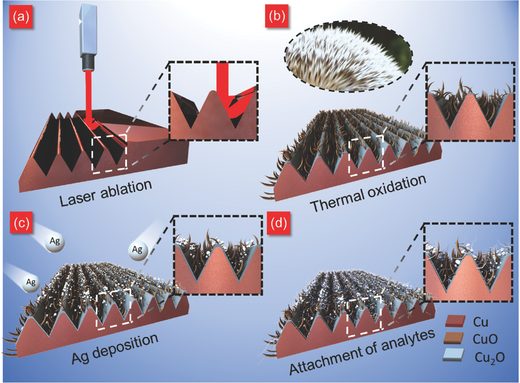Surface-enhanced Raman scattering (SERS) is emerging as one of the most cutting-edge techniques for its intriguing role to demonstrate sensitivity down to the single molecule level.
However, two of the major concerns for the traditional SERS devices lie in their high cost, and waste streams stemming from disposable applications.
The current high-performance SERS substrates with superior sensitivity are principally based on noble metals-based nanostructures, the high cost of, which hinder their large-scale production for practical applications. Meanwhile, most of the SERS substrates can only be applied as single use due to the cross-contamination of probe molecules, giving rise to the production of large-volume biosensor waste.
To reduce the high cost of noble metals-based SERS platforms, and to minimize the negative impact of waste streams, recyclable SERS substrates, as emerging renewable environmentally-friendly biosensors, have attracted considerable research attention, because of their self-cleaning characteristics.
Until now, several strategies have been applied in recyclable SERS, including thermal annealing, UV-light cleaning, and ethanol assisted desorption. Among these methods, UV-light assisted cleaning is a unique approach, which typically relies on wide bandgap semiconductors, such as ZnO and TiO2 as the backbone materials.
However, because of the wide bandgap of ZnO (≈3.37 eV) or TiO2 (≈3.2 eV), UV irradiation (only ≈4% of solar spectrum) is usually required for self-cleaning to achieve reusable ZnO or TiO2-based SERS substrates. This limitation restricts their practical applications

Schematic diagrams of fabricating the ternary Ag/CuO NWs/Cu2O composite.
Inspired by hedgehog-like structures, a research team led by Professor Minghui Hong demonstrated a broadband visible-light-driven photocatalytic SERS platform with the CuO nanowires (NWs)/Cu2O hetero-nanostructures as the backbone.
Professor Minghui Hong states that this, “Broadband visible-light-driven recyclable SERS technique is conceivable to be applied in remote and resource-limited environments for next-generation point-of-care (POC) diagnostics.”
By employing nanosecond laser ablation on Cu sheet coupled with subsequent thermal oxidation, the formed hedgehog-like, high-density and dual-scale micro/nano-structures not only demonstrate enhanced broadband visible-light-absorption capability, even extending to the near infrared range, but also exhibit boosted interfacial adhesion with favorable stability. Such phenomena imply the binary oxidized Cu composites decorated with metallic nanoparticles can be served as high-performance SERS substrates with superior recyclability.
Under visible light illumination, the as-fabricated ternary Ag/CuO NWs/Cu2O composites can be self-cleaned by photocatalytic degradation of adsorbates, thus leading to recyclable SERS substrates, which can preserve more than 85% SERS activity after seven cycles’ measurement. The multiply reusable SERS substrates with distinct features of broadband visible-light-driven capability, and the facile fabrication strategy are conceivable to be applied in the remote and resource-limited environments for next-generation point-of-care (POC) diagnostics.
The next challenges include overcoming the partial dissolution of metallic nanoparticles in solution by long-time photodegradation of the SERS substrates, which leads to the reduction of hotspots and then slight degradation of SERS performance. The recyclable times of SERS substrates should be further improved.
Text edited by Jodie Haigh.

















